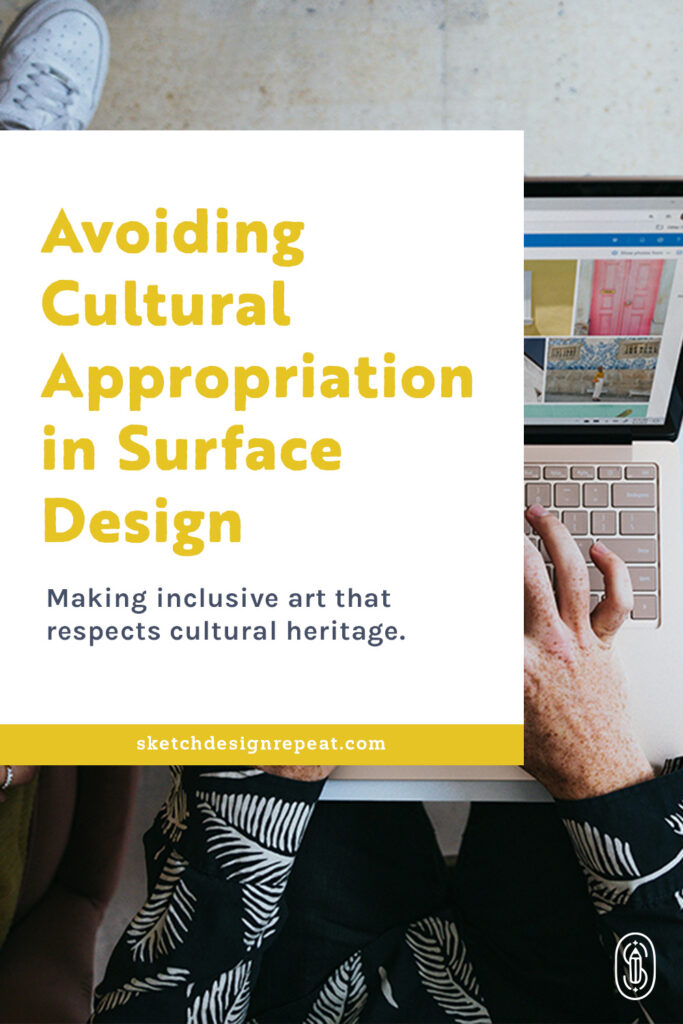I’ve been in the creative industry for nearly two decades, where the importance of copyright and putting your own spin on originality is paramount. While artists undoubtedly build upon existing ideas, the line between inspiration and appropriation can easily blur.

As a designer with a mixed heritage — Mexican American, Native American, and Caucasian — I’ve navigated a complex relationship with cultural identity, making the topic of cultural appropriation particularly nuanced for me.
I haven’t always felt a deep connection to any one cultural community, and this lack of a singular cultural identity has made me acutely aware of the need to approach cultural elements with careful consideration. Intuitively, I’ve always recognized the importance of thoroughly researching and understanding the symbols and motifs I incorporate into my designs.
Cultural inspiration undeniably enriches surface pattern design, offering a vast array of visual elements and stories. However, the complex issue of cultural appropriation arises when considering whether anyone, regardless of background, can freely draw from cultures outside their own.
While cultural appropriation has been a hotly debated topic, it’s essential to distinguish it from genuine inspiration. By approaching cultural elements with respect, understanding, and ethical considerations, designers can harness the power of diverse aesthetics to create inclusive and meaningful work. Navigating this delicate balance requires careful consideration and a deep appreciation for cultural heritage.
Understanding Cultural Appropriation
To grasp the complexities of cultural appropriation, we must first understand the concept of culture itself. Culture is the intricate tapestry of beliefs, customs, and values shared by a group of people. It’s shaped by factors such as geographic location, ethnicity, religion, and personal experiences. Importantly, individuals can belong to multiple cultures simultaneously, as evidenced by my own mixed heritage.
Cultural appropriation occurs when members of a group adopt elements of a marginalized culture without understanding or respecting their original context.
This often involves exploiting these cultural elements for personal or commercial gain without acknowledging their significance or the community from which they originate. It’s a form of cultural exploitation that disregards the historical and social context of these elements, particularly when they stem from cultures that have experienced colonialism or oppression.
The use of distinctive cultural features without considering their historical and social implications demonstrates a lack of sensitivity and respect for the affected communities.
Why is cultural appropriation a concern for surface pattern designers?
The art world has long thrived on cross-pollination, with artists drawing inspiration from diverse sources for millennia. However, this creative exchange becomes problematic when it involves the exploitation of marginalized cultures.
Cultural appropriation often manifests as the unilateral taking of cultural elements, particularly from underrepresented groups, without offering reciprocal benefits or acknowledging the original context. This practice not only disrespects these cultures but also undermines the struggles of their communities for acceptance and recognition.
Engaging in cultural appropriation can severely damage a designer’s reputation and credibility within the industry. Designers who are seen as exploiting cultural elements for personal or commercial gain may face backlash, lose the trust of clients and communities, and find their work devalued.

Cultural appropriation involves a power dynamic where cultures impose their interpretations on marginalized ones, profiting from the mass production and commercialization of these cultural elements without equitable compensation or credit.
As surface pattern designers, we have a responsibility to approach cultural influences with sensitivity and respect, ensuring that we avoid exploiting symbols and motifs. Examples of cultural appropriation in surface pattern design include:
- Using sacred or culturally significant symbols without understanding or respecting their meaning. For instance, employing Native American motifs without acknowledging their spiritual or cultural significance.
- Appropriating traditional textile patterns or techniques without crediting the original culture. This can involve copying intricate designs from Indigenous or ethnic groups without recognizing their craftsmanship and artistry.
- Exploiting stereotypes or caricatures of cultures. This can be seen in designs that perpetuate harmful stereotypes or reduce complex cultures to simplistic representations.
Related Article: 5 Ways to Improve Your Surface Design Illustrations
Inspiration with Respect
When drawing inspiration from other cultures, a mindful understanding of their color, symbol, and technique is crucial. However, exploring and engaging with a new culture can be daunting, leading to hesitation or a tendency to overlook crucial details. To navigate this delicate balance, ask yourself these questions:
- Are you perpetuating stereotypes of other cultures?
- Are you using another culture’s elements, patterns, symbols, or motifs without proper attribution?
- Does your artwork disrespect another culture?
- What emotions do you hope to evoke with your art, and do they align with the cultural context?
In addition to these considerations, self-reflection is vital in ensuring respectful cultural inspiration.
Take time to critically assess your intentions and motivations for incorporating elements from another culture. Ask yourself why you are drawn to these particular symbols or motifs and whether you fully understand their significance. Self-reflection allows you to recognize any unconscious biases or assumptions and helps you approach your work with greater empathy and awareness.

To avoid cultural appropriation, consider these steps:
- Research thoroughly: Delve deep into the source culture, understanding its historical and contemporary context.
- Respect sacred elements: Avoid using symbols or designs with profound spiritual or cultural significance.
- Challenge stereotypes: Don’t reduce complex cultures to oversimplified representations.
- Foster inclusivity: Consider involving individuals from diverse cultural backgrounds in the creative process.
- Engage and collaborate: Build relationships with members of the culture to gain insights and perspectives.
- Give credit: Always acknowledge the source of your inspiration and avoid claiming elements as original.
By following these guidelines and continuously educating yourself, you can create work that celebrates cultural diversity while respecting its origins.

Creating Inclusive Art
Cultural appreciation involves celebrating and honoring a culture with genuine respect. It stems from a desire to learn and understand, valuing diverse perspectives without a sense of entitlement.
Inclusive art is sensitive to power dynamics and avoids misrepresenting marginalized communities. It uplifts the voices and experiences of cultural groups, often requiring collaboration, permission, and equitable compensation.
By centering marginalized voices and perspectives, we can create art that not only celebrates diversity but also challenges stereotypes and promotes social justice.
This requires ongoing education, self-reflection, and a commitment to building authentic relationships with the communities we aim to represent.
A good example is the collaboration between the fashion brand Dior and the Chanakya School of Craft in India. For their 2022 Cruise collection, Dior worked closely with Indian artisans to create intricate embroidery inspired by traditional Indian craftsmanship.
The collaboration was not only about aesthetic inspiration but also about honoring and showcasing the skill and cultural heritage of the artisans. Dior credited the artisans and the school, highlighting the importance of cultural exchange and respect in the fashion industry.
Navigating the complex terrain of cultural appropriation is essential for designers seeking to create inclusive and respectful work. By understanding the historical and cultural contexts of design elements, we can move beyond appropriation and embrace a genuine appreciation for diverse aesthetics.
Through careful research, ethical considerations, and collaboration, designers can harness the power of cultural inspiration to create patterns that celebrate human diversity and foster a more equitable creative landscape.
As a creative with a mixed heritage, I understand firsthand the complexities of cultural identity and belonging. I believe that by fostering open dialogue and embracing our shared humanity, we can create a world where art is a bridge, not a barrier, between cultures. Together, we can create a future where surface pattern design is a force for positive change and build a more inclusive and respectful design community.
It’s important to remember that the conversation around cultural appropriation is constantly evolving. As designers, our learning process should be ongoing, and we must stay updated with new insights and perspectives.
Engaging with this discussion, reflecting on our practices, and remaining open to change are crucial for maintaining the integrity and inclusivity of our work. By committing to continuous education and self-reflection, we can ensure that our designs not only respect cultural heritage but also contribute to a more just and understanding world.

Written by Cody Alice Moore
Website: www.codyalicemoore.com
Instagram: @codyalicemoore
Class: Client Feedback Strategies for Creatives
Cody is an artist, illustrator, and surface pattern designer with over 15 years of experience. Cody discovered surface design while working for four years as an art buyer for a national photo lab. Since 2019, she has been creating art full-time for her budding portfolio and growing collection of licensed designs.